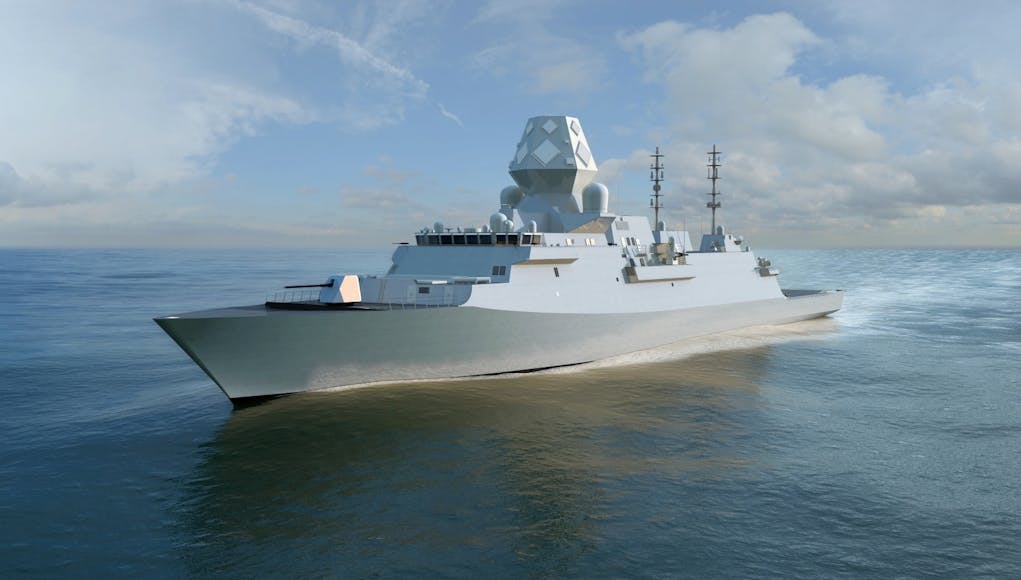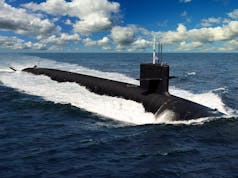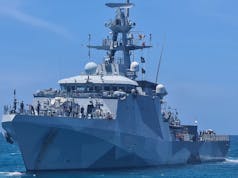The long awaited announcement on the construction of nine new frigates for the Royal Australian Navy has been postponed as the Australian cabinet debates last minute changes to incorporate additional shipyards into the contract.
The project, codenamed SEA5000, currently has three major competitors. BAE Systems with the British designed Type 26, Fincantieri with the Italian FREMM and Navantia with an updated version of the Spanish F100. The nine frigates are expected to start replacing the current Anzac class vessels from the late 2020s.
Media speculation in Australia suggests that BAE are the current favourite. There are indications that a win for BAE with the $35 billion contract could push Australia to the top of the list for a Free Trade Agreement with the UK after Brexit. It is also believed a deal with the frigates and FTA could lead to further arms sales including exporting Thales’ Bushmaster vehicles to the British Army.
A successful export to Australia would also be viewed as a sign of confidence in the Type 26 program on the international market, with the Canadian government also actively considering the design as part of its Canadian Surface Combatant program.
The Australian announcement had been scheduled for last week but has been delayed following the exclusion of Western Australian shipyard Austal from the offshore patrol vessel contract. It is believed that Western Australian MPs are keen for Austal to be involved in the frigate contract instead to prevent any issues with manufacturing job losses in the lead up to the upcoming federal election.
Austal has been one of Australia’s most successful shipbuilding firms in recent years. They have been responsible for the Armidale and Cape class patrol vessels used by the Royal Australian Navy and are currently building the Guardian class vessels under the replacement Pacific patrol boats program. They have also been involved in the design for the US Navy’s catamarans of the Independence and Spearhead classes.
Despite a successful track record, last month they were cut from the $3 billion contract to build twelve new offshore patrol vessels after negotiations with the German firm Lürssen broke down. Lürssen’s design won the contract in November 2017 following an international competition which included a downsized version of the Independence class offered by Austal.
Speaking to ABC News Defence Industry Minister Christopher Pyne would not be drawn on the reasons for the delay or whether negotiations with Austal were underway.
“The Government has said that we will make an announcement about the successful tenderer in mid this year which is June and July,” Mr Pyne said.
“We will definitely do that. If any of the successful tenderers wish to subcontract to Australian shipbuilders like Austal, we’re perfectly open to them doing so but that is a matter for the successful tender.”














T26 favourite, please let it win
Lucky Australia, they will get 9 ships against the RN’s 8? Would raising the RN’s Type 26 to 10 and buy 5 Type 31’s, enable the navy to operate two additional premium ships than receive the full planned and cheaper Type 31’s? I know which I would choose.
An extra two T26s would likely mean the scrapping of the T31 programme on cost grounds. With current levels of defence spending and manning 8 T26 to replace the Asw T23s and 5 T31s to replace the GP T23s (especially if what looks like the highly capable Arrowhead is chosen is the right way forward. If it ain’t broke, don’t fix it.
Every thing crossed…my eyes are watering!
Here’s another article on this – suggests that Australian Defence has nominated T26 and this was ratified by the Aus NSC earlier this month: http://adbr.com.au/sea-5000-decision-delayed-due-to-industry-wrangling-report/
(Chris H) Interesting to listen to what the Rolls Royce top man in Australia had to say in a recent Podcast. Basically the Type 23 is the ‘industry standard’ for ASW especially in quiet running essential for ASW. Type 26 takes that to another level because where other deigns like FREMM and Type 23 use gas turbines to ‘add to’ diesel power for top speeds the 26 uses the MT30 for cruising / ASW search speeds and ‘adds’ the 4 Rolls Royce MTU diesel engines to achieve tops speeds and for high power demands. It is therefore absolutely quiet. And he was a 20 year RN Dolphin.
The additional benefit to this is that Type 26 lifetime operating and maintenance costs are half what others are offering as the MT30 has basically little maintenance demands. As he put it: “You install it, give it a once over occasionally and then remove it when the ship is scrapped.”
have to wish these excellent engineers all the very best
Come on CANZUK Union!!
bushmaster? why?
Can someone please explain to me how this is a good thing for the UK?
1. To be built in Australia – no extra jobs
2. Plans owned by BAe – internal transfer to Australia division at cost, marginal tax income
3. US weapons and combat systems – no increased investment in r&d around the systems.
4. any future upgrades will have to be designed with both wep systems in mind, meaning increased costs
Outside some marginal gains in knowledge share training, I don’t see much advantage for the UK.
Steve….this is a joke, right.
No I am not, I don’t see the benefit to the UK.
If they were built in the UK, then fine, clear jobs boost, but this setup not really.
The hulls and Radar will be built is Australia a significant amount of internal components will come from global suppliers mainly within the UK.
if it wins we will find out, but my guess is most of the components won’t come from the UK, some yes but most doubt it.
It’s not being negative to the bid, just instilling a ounce of questioning to why everyone seems to think it would be a huge positive to the UK.
The French, Italians and Spanish are/were all pretty keen on winning SEA5000 and they don’t make the gas turbines that power their designs. If it comes off, it can also do no harm in the fight for the Canadian frigate design competition.
Steve- your comment is interesting,i cant argue with most of it but surely if the T26 Design is successful it will bring Pride and Prestige to the people who have worked on it so far,plus it validates the skills taken to get it to fruition.Agree that its hard to translate that into hard ££££’s.Perhaps in the future the Australian variant will form the basis of the next AAW ship for the RN (as has already been noted here).
it kinda depends on how much truth there is to the myth of Sampson capability. If the stories are to be believed it’s a big step up on the competition and if true why would we switch it for the Australian designed radar.
a potential option would be to fit future t26 with Sampson but I have no idea if the fixing is strong enough to support such a heavy radar.
Either way the t45 will be around for a while and I suspect that duration will be far longer than their current out of service date, due to yet more future governments unwilling to part the cash in a promptly way.
ANZAC frigates which T26 could replace have CEFAR 1(Phased array) and the SPS 49. The next upgrade that is ongoing gets rid of the SPS49 and replaces it with more phased array panels below the existing CEFAR 1 panels. CEFAR2 L on ANZACS eliminates the need for a long range rotating air search radar.(SPS-49)
CEFAR is good but it is not a AAW destroyer solution radar.
T45 with Sampson and LRR is.
You are being unduly negative about the UK involvement and financial gain from the Australian selection of the T26 frigate.
There will a substantial benefit to the UK, from both high technology items such as the MT30 turbines to the multitude of less glamorous sub systems required.
In addition a royalty will have to be paid to the UK government who own the design. If you recall France paid £200m to gain access to our carrier design, even though they never progressed to a build stage.
Modern warship need to be flexibly designed to allow local build and customisation with weapons and sensors they want rather than being told what they must have.
If t26 wins it will be great for the UK, RN and RAN.
I don’t remember France paying UK for the carrier designs? Was this linked to the plan to carrier share?
(Chris H) Steve – It was quite widely known but it was 10 years ago it was cancelled. The ideas started in 2003 after the debacles of the ‘Charles De Gaulle’ nuclear carrier and President Chirac moved to work towards a mutual design with the British in 2004. In January 2006 the Defence Ministers of France and Britain reached an agreement regarding cooperation on the design of their future carriers. France agreed to pay the UK for access to the design due to the investment made to date. These payments were £30 million in January 2006, £25 million in July 2006 and a further £45 million if France decided to proceed with the project. the French dragged their heels but we proceeded as one was not dependent on the other. It was kicked down the road by Sarkozy (who was no friend of the UK) in 2008 and it basically went the way of so many French Grand Ideas – Re-Specification, re-design and eventually disappeared in late 2009
I am not sure if any further payments were made.
£24m+45m doesn’t add up to £200m, i assume the 45 wasn’t paid but even with it? The maths is slightly out somewhere. No doubt most of that £69m was lost in price increases caused by the negotiations around France joining.
However it is a different situation, entering at design phase and then i assume having a say in the ultimate final design features, is very different than just buying a design off the shelf.
Even if the same 69m (i assume much less in this case) is not real value, when the program is multi billion.
I still am struggling to see the huge advantage to the UK.
I hope i am missing something.
It is not an off the shelf design.
The ASW will be British although branded French.
The AAD will be Australian and if our Batch 2 T26 have that, they will be world beating!
I think they will have to pay royalties to BAE for each ship, and there will be an agreement to supply a good chunk of components through UK suppliers. Tarrif free of course.
We also get maintenance, training and maybe basing in the Asian theatre. Expect their ships to provide ASW cover for our carriers.
Being able to order parts in bulk reduces the cost for both nations, same will go for Canada. Too bad the US wont buy. If only there was a way to change somebodys mind about that….
how will it reduce the cost to the UK, we have already agreed the price for ours?
The escort comment is fair although any frigate could do this job, it doesn’t have to be a UK designed one. Although the silent hull is important.
A good chunk will of course be paid to BAe but it will be paid to BAe Austalia subsidiary and taxed there, which means minimal benefit to the UK.
Who knows on the volume of parts, we won’t know either way until construction starts. However as they are installing their own combat managemtn system and weapons and will use their own steels, that volume is already likely to be low.
Don’t get me wrong, we need our stable allies to have the best gear to fill gaps in our own capability, so that is a clear advantage here and there will be some investments flowing back, just I doubt as much as people here suspect.
Without the blueprints, all they have is shedloads of fancy metal and oodles of weapons without any logical place to put them. Since the design for type 26 are owned by the British government, they will have to purchase these at a cost, or pay royalties to use them. The “smarts” after all, is what makes engineering difficult.
Any muppet with a blow-torch can bolt some metal together and call it a ship.
Are the plans fully owned by the UK government?
Let’s see how much the plans are worth, but I can’t help thinking we will pretty much give them away, so the UK Gov can announce a big export deal in a period of uncertainty around brexit, without giving too much details on how it economically benefits the UK.
No not everyone can bolt or weld a ship together.
Great ships take workers with skill to build to any quality. As otherwise you will end up with complete trash or no ability to turn a designers vision into reality. Yards capable of building or refitting modern warships are rare and the workforces that make them possible valuable national resources. If you have neither you have to spend vast amounts of money buying equipment and technical advisers from other countries every time you have to replace ships in service.